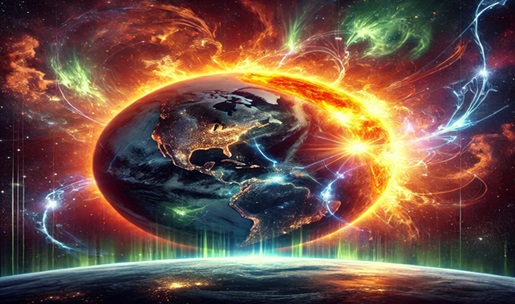
- A solar storm is an explosion of intense energy and charged particles emitted by the Sun.
- It spreads very quickly into space and when it collides with the Earth's magnetic field, it gives rise to a variety of events.
- This storm is mainly associated with two phenomena:
- Solar Flare - intense energy explosion on the surface of the Sun.
- Coronal Mass Ejection (CME) - huge emission of plasma and magnetic field from the Sun.
How does a solar storm occur?
- When instability occurs in the magnetic field inside the Sun, it can explode near sunspots on the surface of the Sun.
- In this process, a large amount of energetic particles, radiation and plasma spread into space, forming a solar storm.
- When these particles collide with the Earth's magnetosphere, they cause geomagnetic storms, which can affect satellite communications, radio signals, and power grids.
Classification of Solar Storms
Solar storms are classified into five categories based on their intensity:
|
Category
|
Impact
|
|
G1 (Minor)
|
Slight satellite disruptions, polar lights
|
|
G2 (Moderate)
|
Minor impact on radio signals and power grids
|
|
G3 (Strong)
|
Disruptions in GPS and communication systems
|
|
G4 (Severe)
|
Blackouts, damage to satellites
|
|
G5 (Extreme)
|
Communication and power networks shut down, global auroras
|
What are Solar Flares and Coronal Mass Ejections (CME)?
Solar Flare
- A sudden, intense explosion of energy and radiation on the Sun’s surface.
- Emits X-rays and ultraviolet (UV) radiation.
- Can disrupt radio communication and GPS signals.
Coronal Mass Ejection (CME)
- A massive explosion of charged plasma and magnetic fields from the Sun.
- These particles travel at speeds exceeding 1 million miles per hour.
- When they collide with Earth’s magnetic field, they trigger geomagnetic storms.
Effects of Solar Storms on Earth
Impact on Communication and Satellites
- Radio signals and GPS networks can be disrupted.
- Spacecraft and satellites may suffer damage.
Effect on Power Grids
- Solar storms can induce currents in power transformers and grids, leading to blackouts.
- In 1989, a geomagnetic storm caused a complete power outage in Quebec, Canada.
Space Radiation and Astronauts
- Intense solar radiation poses a health risk to astronauts.
- Scientists aboard the International Space Station (ISS) take special precautions to shield themselves.
Spectacular Auroras on Earth
- When charged particles from solar winds interact with Earth's atmosphere, they react with oxygen and nitrogen, creating colourful light displays.
- In the Northern Hemisphere, it is called Aurora Borealis, and in the Southern Hemisphere, it is known as Aurora Australis.
Solar Activity Cycle and Solar Maximum
- The Sun follows an 11-year cycle of active and quiet phases.
- When the Sun is at its most active, it is called Solar Maximum.
- During this period, solar storms and sunspot activity increase.
- Scientists predict that by 2030, we may experience a peak solar maximum, increasing the risk of powerful solar storms impacting Earth.



